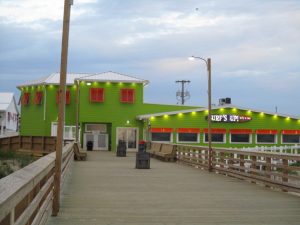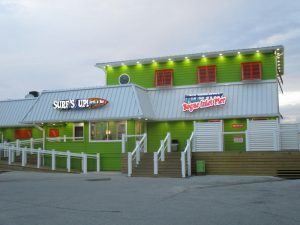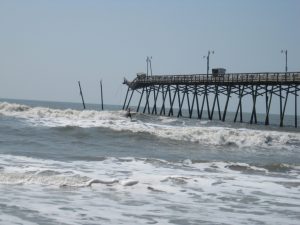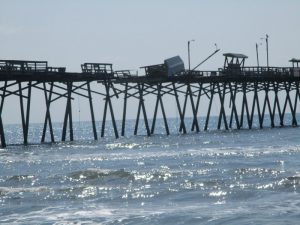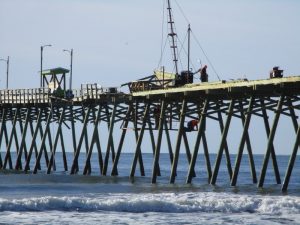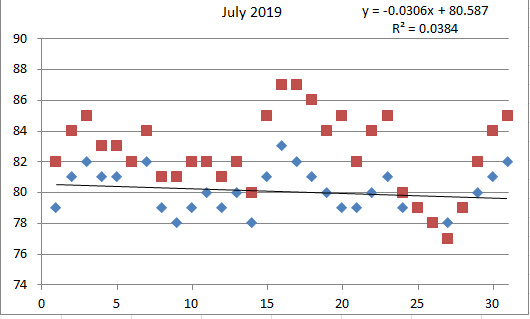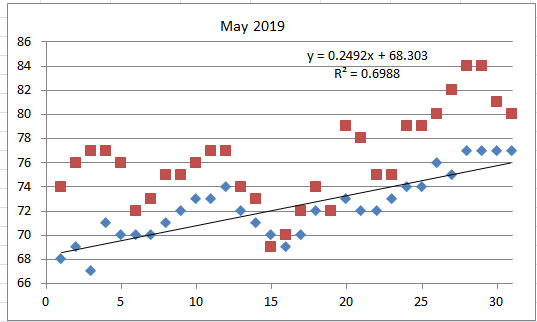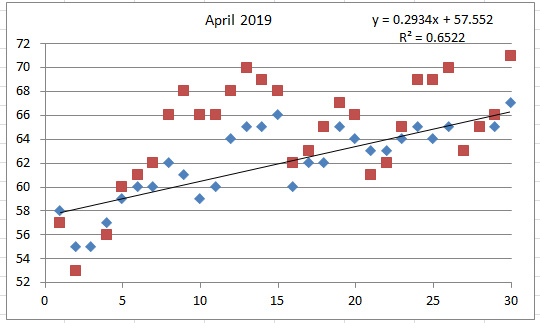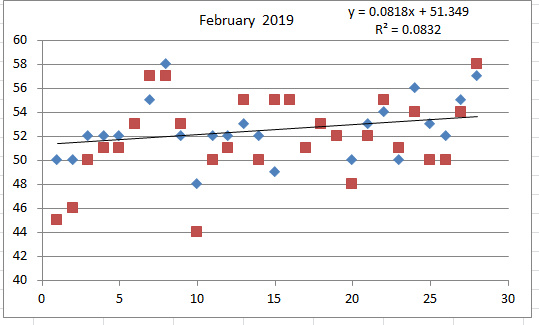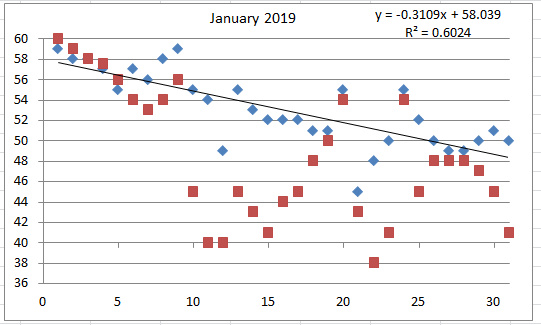Coastal Daybreak Radio Show WTKF 107.1, FM 1240 AM, Host Ben Ball, on 6/3/19
Dr. Bogus: Our guest today is Mike Stanley, owner/operator of Bogue Inlet Fishing Pier. We have done stuff on and off together for over 25-years. Mike can you give people a bit of the history of Bogue Pier then we can get into not only the past but present and future of Bogue Pier. When I built my house here in Emerald Isle in 1992, I think we had 8-piers on the island, including the Sheraton/Double Tree.
Mike Stanley: Which was Morehead Ocean pier back in the day.
Dr. Bogus: And now we’re down to two! For people that want to get some information about the history of North Carolina’s fishing piers, there is an excellent book by Al Baird , we’ve had him on the show too, North Carolina’s Ocean Fishing Piers from Kitty Hawk to Sunset Beach. It gives you a really good history. And so why don’t we get into the history…the past of Bogue Pier.
Mike Stanley: Well the pier was built in…was started in 1959 and finished in 1960. It was built by WD McLean and George Spell…
Dr. Bogus: Names we know!
Mike Stanley: They were trying to get more people toward the western end of Emerald Isle and the new development down there. And the ferry had just come in at that point so they wanted to get something rolling, and they did. I’ve been coming there since 1967, so the pier wasn’t very old when I started coming. Of course there were the camp grounds; it was just a charming little place at that point in the Bogue Inlet area.
Ben Ball: A lot of times those were entertainment venues as well at that point in time.
Mike Stanley: It was just so basic; you could drive your unlicensed Jeep down the beach drinking a beer waving at the cops! And everybody was happy and everybody got along great. Such a different time we were blessed to be able to be there at that time. But over time my family, my father and my uncle bought the pier in 1971, and my uncle Melvin always wanted a fishing pier, he wanted THAT fishing pier. And so my father chimed in with him and the day after I graduated high school in 1972 I moved to Emerald Isle and I’ve pretty much been here ever since.
Dr. Bogus: You’ve been a fixture for all that time!
Mike Stanley: So you know over the years we’ve lost the pier, we’ve put it back we lost the pier we’ve put it back.
Dr. Bogus: Like catching a red drum yo-yo, comes in goes back out…
Mike Stanley: We’re at the point now where just one more little group of pilings, about 18-sections of pilings and the whole pier will have been completely replaced as of 2012! We’re “pretty high cotton” now if we could just keep the storms reasonable things will be fine for us.
Dr. Bogus: Bogue Pier was built in that location, just inshore of the Keypost Rocks and I think that that was a key that helps it to be a good fishing pier.
Mike Stanley: And its proximity to Bogue Inlet which is only about 4-miles.
Dr. Bogus: Yes just about 4-miles to the west. So you’ve got the inlet and the Keypost Rocks just offshore that can hold the king mackerel and some of the bigger fish that come in there as well. How has the season gone so far Mike as far as the fishing?
Mike Stanley: We’ve had…everything, knock on wood, amazing. Fishing has been great sea mullets, pompano, black drum…
Dr. Bogus: Sea mullets have been the best I’ve seen in the 20 odd years, that’s probably the best I’ve ever seen it.
Mike Stanley: It’s been something else, they just keep coming which is really great, and of course the spots are just starting to hit a little bit.
Ben Ball: A big favorite for inland fishermen to come down when the spots are hitting.
Mike Stanley: Spots are our BIG thing, so hopefully that will continue.
Dr. Bogus: One of the things, the pier looks a lot different now obviously in the 1960s and 1970s but one of the big things over the last couple years is rebuilding the pier house and restaurant. You knocked down the old original pier house and replaced that couple hundred feet of pier over the sand area.
Mike Stanley: Exactly, at my age going in that kind of debt is not really a smart thing to do, but then again owning a fishing pier I’m not sure if that’s a smart thing to do either. But actually it’s been quite a joy to do it; it was time everything had aged to a point where we just couldn’t fix it any longer. So we just went in and wiped it out and started all over again, which was the most wonderful thing. We’ve got the highest technology, foam insulation, air-conditioned…we’ve never seen that before.
Ben Ball: Tell us about the restaurant part.
Mike Stanley: Surf’s Up Grill & Bar comes in after Bushwacker’s, which was now many years ago, and we tried to make it a little bit more laid back and not so dinner oriented. It’s more of a bar and grill, bar and sandwich shop and they really have some nice stuff.
Dr. Bogus: I’ve had breakfast there on Sunday’s sometimes.
Mike Stanley: It’s just a really nice place to go. It’s got access to the beach on the ramp from the outside. It’s done real well, it’s really cute inside, we have a Volkswagen bus on the wall and all kinds of fun things in it. That was a fun challenge, but that was after we rebuilt the pier house so it was a real challenge to put it all together so quickly.
Dr. Bogus: And you have that bar that runs across the south side, so it looks out over the water and sit on the stools there look at the beach see what’s going on, on the pier. So it’s a nice change from what you remember. You rebuilt that front part of the pier and of course this year if we go back, I remember when Bertha and Fran came through and Floyd came through and Irene is another one that took a chunk out.
Mike Stanley: My favorite, but you get to a point where you…you just kind of survive it you roll up your sleeves and you just get on with it and ultimately it’s all worth it! It all comes back because people are excited about it they appreciate the fact that we do care enough to keep it there, and that’s something I think that needs to carry on regardless of whether I’m here or not.
Ben Ball: There’s also generational history people that go out there remember going out there with their grandfathers.
Mike Stanley: And today there are generations that are making memories so that’s something we strive to do is to help people, especially with the kids get them a memory give them some kind of a memory.
Dr. Bogus: One of the things that has always been said about Bogue Pier is that it’s probably one of the best maintained piers around and that’s one of the attractions is that it is so well maintained.
Mike Stanley: I’ve always been a person in business it’s my belief that if you give people what YOU want then they will come. And I’m a stickler so it’s got to be done right, we’re really trying to keep it all up and we appreciate everybody coming on out and enjoying the place with us.
Dr. Bogus: And last year of course the ultimate nastiness, Florence came through. What was damage there; you had several breaks in the pier from her.
Mike Stanley: Florence was Mother Nature just slapping me. She understood that I had some weak spots in the pier and she sure showed me the weak spots. We had five sections actually lost, and we went in and looked we had 36-sections that were needing rebuilding and so we did 18-sections this past year and we’re going to do the other 18-sections this coming year. And then we will have all the pier rebuilt and solid because the way that we rebuild it today it’s way better since Irene. The technology that we put in it now is so much stronger.
Dr. Bogus: It’s fascinating to watch you guys…it looks tricky but it seems like you get a rhythm going.
Mike Stanley: It is!
Dr. Bogus: And you get the pilings in get the decking it seems to roll along at a pace like that.
Mike Stanley: Once you get the momentum going…getting started is the pistol. If you can get the rhythm, once you’ve got it it’s good it moves along real well.
Dr. Bogus: One of the problem this year of course is you had a lot of competition for labor, trying to rebuild Bogue Banks, Emerald Isle and trying to get people out there with all the other rebuilding going on.
Mike Stanley: That was probably the worst part of rebuilding this time was the fact that it was very difficult to find skilled labor that was strong enough to pick up 300-pound beams.
Mike Stanley: We had a really good crew this year and I’m hoping that we’ll be able to bring the same crew back for next year and get it out of the way.
Dr. Bogus: We’ve talked the past and present so now Mike let’s look into the future. You said that you’re going to replace those other remaining 18-sections between the water’s edge, that you replaced a couple of years ago and the new section that was replaced from Florence. So what’s the plan?
Mike Stanley: Our plan, what we’re thinking is we would really like to put in a wedding style gazebo, a wedding venue out on the pier. We’ll stretch the pier out from 20-feet wide to 44-feet wide and then you will be able to walk around it, you’ll be able to fish around it, everything will be business as usual but there will be a 20’-by-28’ gazebo with a deck over top so that you can get married on top and have the wedding reception underneath. That would be really a lot of fun, something to bring people down and cherish and give them more memories for what it is.
Dr. Bogus: For this you’ll still have to get some approval from CAMA.
Mike Stanley: We’ll have a presentation for their consideration and I think that CAMA has become upbeat system and their understanding and working with the public trying to produce products for the public, get them out there. It’s definitely in their interest and the state’s interest and that’s kind of what we’re after.
Dr. Bogus: And so if you get approval for these proposed changes to the pier, when will you do the final replacement of the now oldest 18-sections.
Mike Stanley: Hopefully if we can get everything in line and don’t have a whole lot of obstacles, we will probably start the first of December at the day we close for the season and we should be completed by the first of March.
Dr. Bogus: We know how those plans go. It’s so weather dependent, aside trying to find people to do the reconstruction this past year, you also had to struggle with the weather…wind, rain, cold the gloom of night!
Mike Stanley: It’s all a challenge, at this point in the game it’s becoming materials too because we’re buying big beams and it takes a little while to get the timbers. So supplying the timbers is a little bit more of a challenge to get them, but we try to order far enough ahead that we can get everything we need.
Dr. Bogus: You have your list of stuff?
Mike Stanley: I’m getting one and gathering the help. I have in my mind what I need.
Ben Ball: Meanwhile the fishing has been pretty good.
Mike Stanley: It’s been good. Right now it’s not as wide open as the early spring was, but they’re not doing bad, I’m really happy with what they got. We’ve had some really nice pompano this year.
Dr. Bogus: What we need now is have some of those king mackerel start coming in to the pier. It’s interesting because the catches of king mackerel just off the shore at Keypost Rocks or any of those areas, just a mile or two offshore is pretty good right now and I guess you still need some bait coming in close to the pier to drag them in.
Mike Stanley: It’s a crazy thing, we had a couple kings that they lost a couple weeks ago, and one of them weighed probably about 40-pounds. That’s usually the case the first kings in the spring are usually really good sized.
Dr. Bogus: And I know the other day they were chasing a cobia…I could just see it, three guys with bucktails trying to chase down a cobia swimming by the pier.
Mike Stanley: I’d love to see some cobia they’re great fish…
UPDATE ON THE PIER FROM MIKE STANLEY (8/22/19): “I have decided not to pursue the wedding deck. CAMA was very helpful but I just don’t see it happening right now. We won’t be doing any construction on the pier this coming winter, so Season Pass holders will be able to access the pier all winter (except for maintenance). Thanks!”
Check out www.bogueinletpier.com, and the Bogue Pier HD camera, or call them at 252.354.2919.

